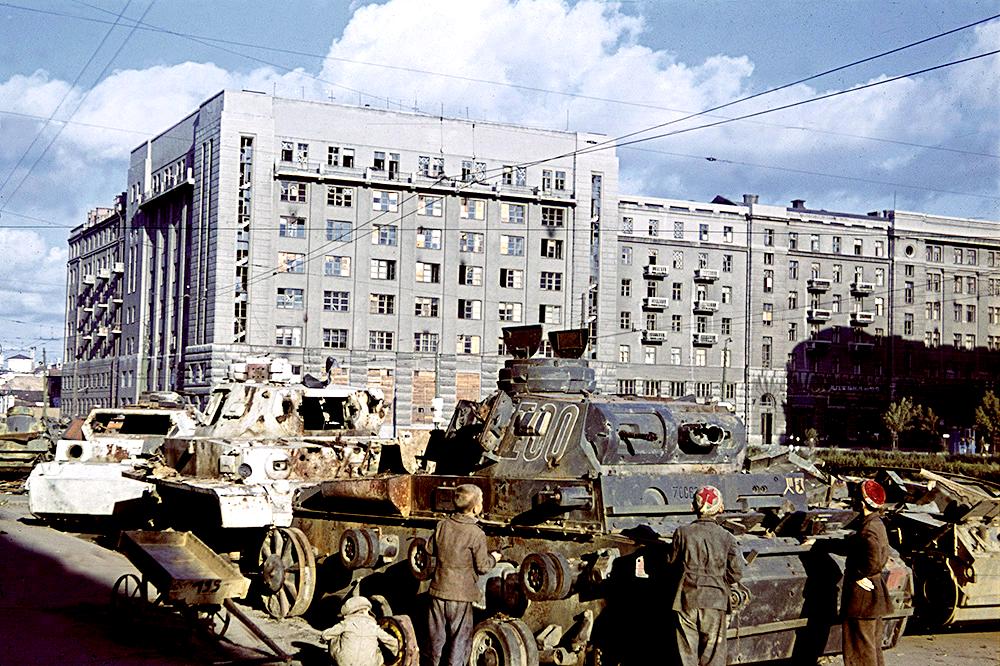
World War II: Kharkov/Kharkiv (October 1941-August 1943)

Figure 1.-- Kharkov was the largest Soviet city seized by the Germans. It was finally liberated by the Red Army (August 23, 1943). The city after four fierce battles was in shambles. The apartment complex in the background was a rare important building that was not heavily danmaged. The city was littered with shatered tanks and other military vehicles. Some of the German tanks were towed to the center of town where for some time after the War they remained as trophies of War. Here some boys are inspecting the destroyed German armor, notice their Ukranian caps. The tank in front is the Mark III (E) with the main gun removed. The Mark III was the principal German tank in the first years of the War. The 3.7 cm cannon and armor, however, was totally outclassed by the Soviet T-34, but was still being used by the Germans alongside the more advanced German Panzers.
|
|
Kharkiv/Kharkov is the second-largest city in Ukraine. At the time of World ar II it was the largest city, slightly larger than Kiev. It is located in the northeast of the mow independent country. It became the most fought over city of the Eastern Front, meaning Workld War II. Unlike most World War II battles, it was not a single engagement, but a series of four fierce struggles. Four major battles were fought over Kharkov before being finally liberated by the Red Army (August 23, 1943). The city was captured and recaptured by by the Germans during Basrbasrossa (October 24, 1941). A disastrous Red Army offensive failed to liberate the city (May 1942), paving the way for Opertion Blue-the Stalingrad/Caucasus campaign. Khrushchev at the 20th Party Congress would blame Stalin for the disaster. [Khrushchev] The city after the Stalingrad victory was liberated by the Red Army (February 16, 1943). It was retaken a second time by the Germans in a masterful operation overseen by Manstein (March 15, 1943) before being finally liberated for good after the Kursk victory where Mainstein failed (August 23, 1943). By this time the material superiority of the Red Army and its increasingly competent leadership could no longer be matched by the Germans. After Kursk and Kharkov the Germans could inflict sedrious casualties on the Siviets, but no longer blunt theur offensives, even un the summer. In addition, men and equioment had to be diverted West to stop the Allies in Italy and prepare for the Cross-Channel invasionnoiw expected in 1944. The city was in shambles with 70 percent destroyed and tens of thousands of the civilian population killed. Kharkov at time was the third largest city in the Soviet Union and the most populous city captured by the Germans. There was an important Jewish community in Kharkov. They worshiped in the second largest synagogue in Europe. After taking Kharkov the Germans set about methodically murdering some 30,000 Jewish inhabitants (December 1941 and January 1942). About half were shot in a ravine outside of the city -- Drobytsky Yar. Kharkov had an important tank production complex, but the city was far enough east that the Soviets were able to successfuly evacuate it east of the Urals. It became the heart of Red Army's tank programs (producing the iconic T-34 tank). The tank enterprises returned to Kharkov after the war and continue to produce tanks. The city had a ore-War populsation of 700,000 inhabitnts. The Germans rounded up 120,000 people and transported then to the Reich as Ost-Arbeiter (slave labor) and murdered 30,000 people (mostly Jews). Some 80,000 people starved to death because the Germans only issued ration cards to the people working for them. [Subtelny]
Sources
Khrushchev, Nikita. Edward Crankshaw, intro, commentary, and notes. Strobe Talbott, trans. and ed. Khrushchev Remembers (Little Brown: Boston, 1970), 639p.
Subtelny, Orest. Ukraine: A History 4th Edition (University of Toronto Press: 2009)
CIH -- WW II

Navigate the CIH World War II Section:
[Return to Main World War II Second Phase page]
[Return to Main World War II campaign page]
[Biographies]
[Campaigns]
[Children]
[Countries]
[Deciding factors]
[Diplomacy]
[Geo-political crisis]
[Economics]
[Home front]
[Intelligence]
[POWs]
[Resistance]
[Race]
[Refugees]
[Technology]
[Bibliographies]
[Contributions]
[FAQs]
[Images]
[Links]
[Registration]
[Tools]
[Return to Main World War II page]
[Return to Main war essay page]
Created: 9:15 PM 4/28/2018
Last updated: 9:15 PM 4/28/2018



